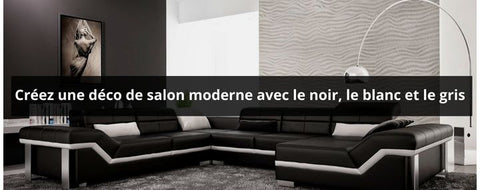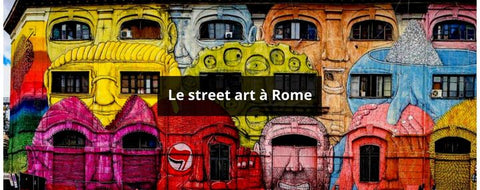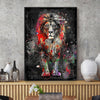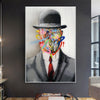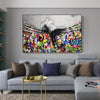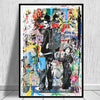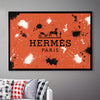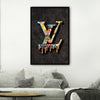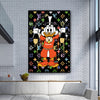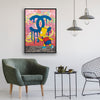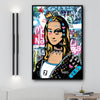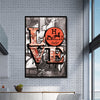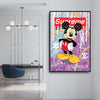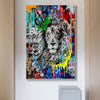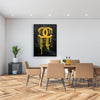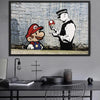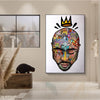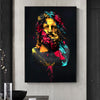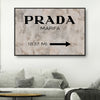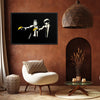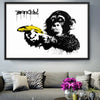
Felipe Pantone, the trendy street artist
Are you passionate about the famous "Pant" or "Felipe Pantone"? Are you curious to know who Felipe Pantone really is? Perfect timing, because we're also passionate about the works of this street artist!
Renowned for his futuristic writing style and kinetic art, Felipe Pantone is a contemporary artist of Argentinian-Spanish origin who has enjoyed great success in the world of street art for several years.
In this article, you will discover:
- His biography and career paths
- His perception of art in the contemporary world
- The expansion of his works
After reading this article, the life, career, and unique style of Felipe Pantone's art will no longer be a mystery to you. You'll also learn about the sources of inspiration for this artist who takes us on a journey through an ultra-modern world of vibrant color blends. Let's go!

I) Who is Felipe Pantone?
1) The Argentinian graffiti artist in the streets of Valencia
Felipe Pantone is a young graffiti artist and contemporary artist. Known by the pseudonym "Pant" or "Patone," he was born in 1986 in Buenos Aires. Around the 1990s, he and his parents, when he was 10 years old, moved to Spain where he spent his adolescence. It was in Spain that he discovered and explored his passion for street art . From a very young age, he was fascinated by the art of graffiti.
From the age of 12, he began expressing his art by drawing classic tags and writing on the shutters and walls of his city. It could be said that he was interested in all kinds of calligraphy, lettering, and typography. After finishing secondary school, Felipe studied at the University of Valencia, Spain, and subsequently earned his degree in Fine Arts. He currently lives in Valencia, where he has established his own studio.

2) A talented street artist conquering the world
Before achieving worldwide fame, this young artist constantly developed his style, notably through his self-taught training. It was in 1998 that he began to gain recognition, particularly in Buenos Aires, his hometown, where he created numerous murals . During this period, he had a pivotal encounter with Richard Mirando, who hired him as an assistant.
Working with Seen ( Richard Mirando's artist name) , he gained valuable experience that allowed him to build his international reputation and discover how to monetize his art. Under the names "Pant" and "Pantone," he expanded his mural projects in outdoor spaces, as well as undertaking other large-scale projects such as monumental installations, creating a new concept: street art reinvented .
3) Felipe Pantone, a discreet graffiti artist
Like Banksy , Filipe Pantone prefers to remain anonymous to showcase his work. According to the young street artist, it's his art that should be known, not his face or identity. "For me, graffiti is more of a game than art."
For him, this beginning wasn't easy, as he had several run-ins with the Spanish justice system due to his illegal artistic endeavors . He wore a mask to conceal his face, evading the police and preventing his image from appearing online or in magazines. Currently, he still avoids the public eye, even in interviews. Since then, he has only ever appeared in public wearing a mask, glasses, and his signature blend of classic and contemporary style. Furthermore, his personal life has never been revealed and remains entirely private.
II) His perception of art in the contemporary world
1) The Pantone style: futuristic and unique
Known for his street art style that combines graphic design and geometric shapes, Pantone enjoys playing with color and light. His art showcases his originality and personality, translating classical geometry or blending pop art and graffiti art. Felipe's signature style focuses on the artistic movements of Kinetic Art, Op Art, and colorful geometric painting .
Drawing inspiration from the present day and new technology, he wants his work to be democratic and accessible to all. As Pantone stated, "Color exists only because of light, and light is the only reason why life exists."
Filipe Pantone grew up in the generation that witnessed the birth of the internet. He has been able to express his vision of the rapid evolution of the digital world. His artistic style is based on the intersection of the past, present, and future. To successfully blend kinetic art, optical art, and abstraction, he has used 3D visual software, 2D pen printing, and laser cutting to create extraordinary futuristic works.
Pantone's art is instantly recognizable by its layering of colors, the precision of its lines, and its geometric shapes. His futuristic style results from a blend of kinetic art, optical art, and street art.

2) Artistic freedom according to Filipe Pantone
For street artists, the urban environment is the primary space for expression . Filipe Pantone, too, has always preferred to draw in urban spaces since his beginnings. His philosophy? Artistic freedom. He wanted to reject artistic conventions to create an original and unique style, entirely his own.
As he said: "I grew up as a painter, I trained as a painter, and now my biggest goal is to get rid of all the academic training and be able to make art freely, with whatever tools work best for me."
Between his talents, colors, and forms, this artist has chosen artistic freedom . The fundamental principles are therefore merely an enrichment of experience.
Versatile and self-taught, Pantone diversifies his work, ranging from works of art to large-scale infrastructure projects. This includes creating artistic paintings, illustrating graffiti on public walls, and painting buildings and moving objects such as cars and airplanes. Indeed, this graffiti artist enjoys producing art everywhere, whether on a small scale, as in his collaboration with the watch manufacturer Zenith, or on a large scale when he tackles building facades.

3) Pantone's inspirations
Every work of art is born from a spontaneous and remarkable inspiration. Creating such masterpieces requires a unique and extraordinary capacity for visualization. Each artist draws their inspiration differently. As we saw earlier, Pantone is a self-taught street artist who approaches his futuristic creations with a colorful, pixelated concept, while adding an abstract and stroboscopic touch .
During an interview at an exhibition in Australia, at Stereodynamica in the Backwoods Gallery in Melbourne, he cited his inspiring artists: Victor Vasarely, known for his optical art; Alan Turing, the creator of the first computer; and Carlos Cruz-Diez, a prodigy of kinetic color art.

III) The artistic work of Felipe Pantone throughout the world
1) His three-dimensional graphics in outdoor installations
Pantone reproduces three-dimensional graphics on outdoor installations. This illusionist transforms these spaces into eye-catching masterpieces nuanced with color. He loves to impress people with his majestic art on monuments, enormous walls, long bridges, and more. His work is appreciated worldwide.
A) Pixel Art on the University's facade
In Spain, one can cite the "Pixel Art" on the façade of the Polytechnic University of Valencia's Faculty of Fine Arts. It was one of the most prestigious design works of his, covering an area of 330 square meters. To create this piece, Pantone used more than 500,000 ONIX mosaic tiles in just six colors. On this façade, the artist transcended fiction. Every corner is perfectly pixelated.
B) The Monterrey by Felipe Pantone
In Mexico, there are several buildings painted by Felipe Pantone, hence the name of the Felipe Pantone 1 to 17 project. This one is located in Monterrey. The building's facade was painted with a variable chromodynamic image, like one of his kinetic art paintings, "Variable Chromadynamica (Color)".
C) Data Somersault in Paris
In France, the "Data Somersault in Paris" was located in the Palais de Tokyo in Paris in 2016. He completed this project as part of the Lasco Project in just five days. In this tunnel, he created a work inspired by digital technology and the aesthetics of the three-dimensional world.

2) Felipe Pantone, an artist who shines in exhibitions
Over time, he has shared his artwork with street art enthusiasts as well as in art galleries.
In 2018, he exhibited for the first time in France at the Danysz art gallery entitled "Dynamic Phenomena", where he presented his various paintings and dimensional creations such as: "Optichromie 99", the "W3 Dimensional 25", "Chromadynamica 49", "Chromadynamica Dimensional 2".
"Speeding," "Afterimage," "Big Time Data," and others... are also the occasional events where he has presented his creations.
3) Notable artistic collaborations
A) Felipe Pantone and Hennessy
The renowned cognac house Hennessy has partnered with contemporary artist Felipe Pantone to create a limited edition of its iconic cognac. The result is a cognac bottle that becomes a work of art, paying homage to contemporary aesthetics.
The bottle's design is striking, with its intricate interplay of geometric shapes and vibrant colors characteristic of Filipe's style . Pantone employed digital design techniques to create this unique bottle, inspired by technology and futuristic visions. The patterns and colors are intense, vibrant, and utterly unique. The bottle is available on the Hennessy website for €35; please note that this is a limited edition, so production is limited.

B) Felipe Pantone and Zenith: a bold collaboration
Felipe Pantone has partnered with the Swiss watch brand Zenith to create an incredible watch collection. The collaboration has resulted in a series of watches with a futuristic and innovative aesthetic .
In a recent interview, Pantone explained that the idea of collaborating with Zenith came naturally to him. He has long admired the Swiss watch brand for its expertise and quality. For him, it was an opportunity to work with a company that shares his creative vision and attention to detail.
The Pantone Zenith collection features a series of watches that push the boundaries of horological design. These timepieces are equipped with a high-precision automatic movement and an ultra-resistant titanium case. But what truly captures attention is the futuristic and colorful design of these watches.
The watches feature a carbon fiber dial, which offers a striking contrast with the fluorescent details. The colors are vibrant, the geometric shapes are intricate, and the light effects are mesmerizing.
Pantone explained that his collaboration with Zenith was an opportunity to push the boundaries of his own creativity. For him, working with different materials and manufacturing techniques was an enriching and stimulating experience. He believes this collaboration offers art and watch enthusiasts the chance to discover something truly unique and innovative.

C) Felipe Pantone Alpine
As a free and passionate artist, Pantone didn't limit himself to displaying his art on buildings in public spaces; he also featured it on motor vehicles. He has a passion for automobiles, which he highlights through his art, representing speed and power.
One of his remarkable projects was to transform a 1994 Chevrolet Corvette "Ultradynamic" into a futuristic concept car. Following this achievement, his collaborations with manufacturers continued. In 2021, he partnered with driver Fernando Alonso to create the one-of-a-kind Alpine A110. He designed the Alpine's livery for its Formula 1 debut.

You know everything about Felipe Pantone
Are you fascinated by Felipe Pantone? Have you been wanting to learn more about this rising star of kinetic art? Now you know (almost) everything about him. He's a visual artist with a unique and striking style. His use of color, light, abstract forms, and patterns evokes the singularity of his works. If the world of kinetic art captivates you, we invite you to explore our beautiful collections of his street art.
To thank you for making it this far, enjoy a 15% discount on your order today with the promo code: BLOG15 .
See you soon.
The Lofty Trend Team.




